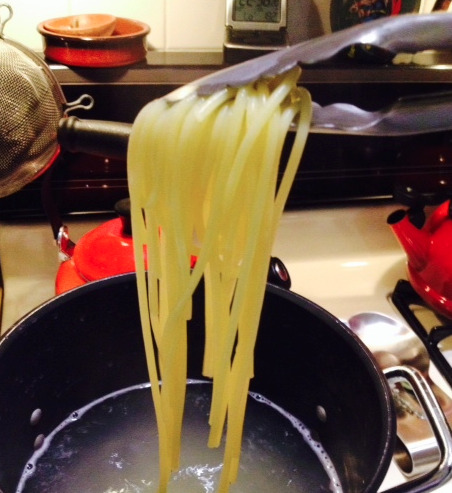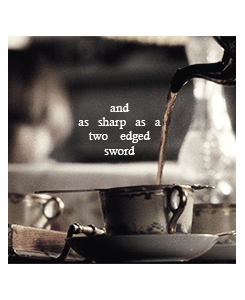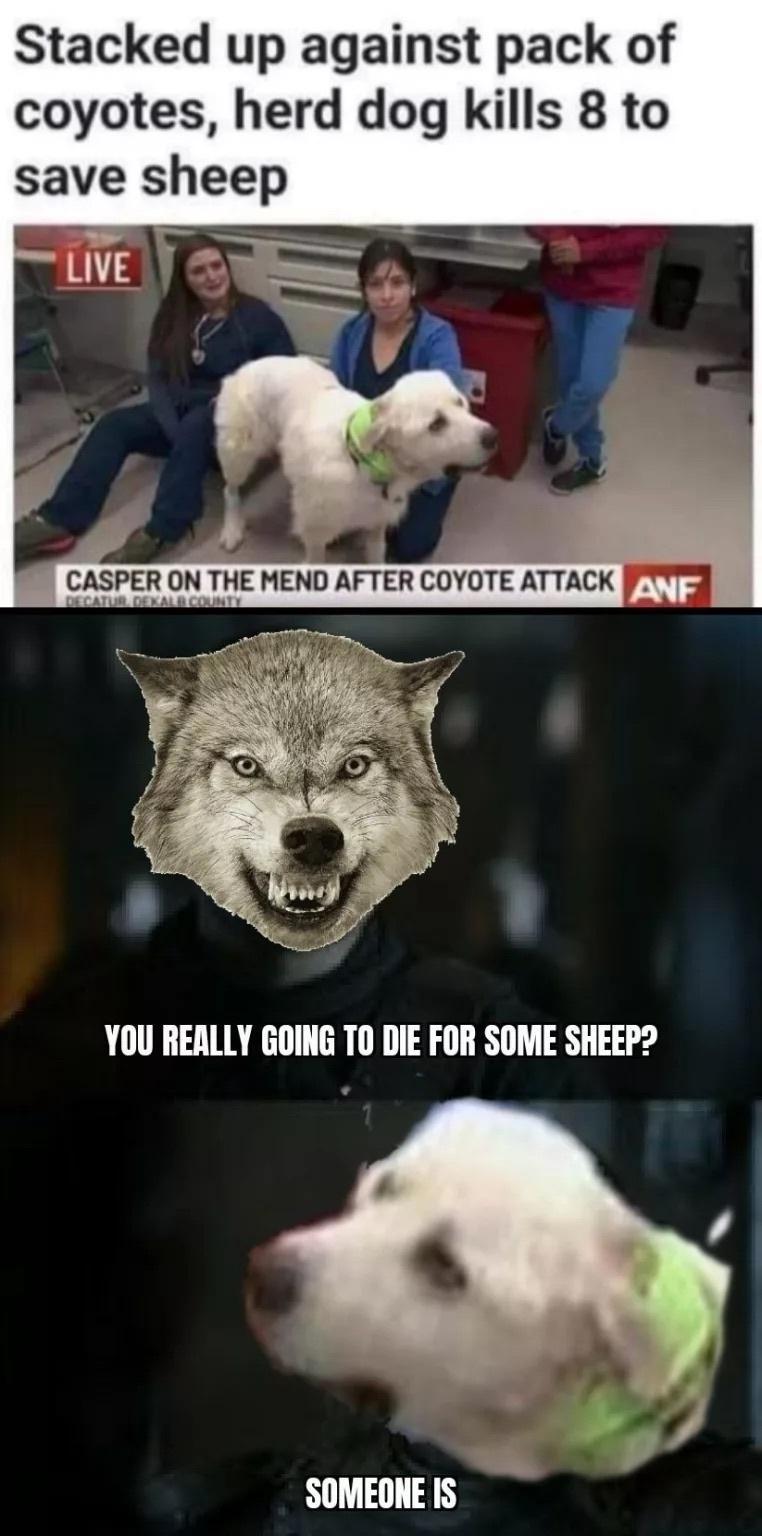Pasta Is Great. It’s Like Hey, Let Me Take Delicious Things Like Butter,or Meat, Or Tomatoes Or Basil





Pasta is great. It’s like hey, let me take delicious things like butter,or meat, or tomatoes or basil and then let me just fuckin mix whatever the fuck i want in and combine it with some random ass noodles. That’s basically pasta. BUT, there’s a big difference between “basically pasta” and “holy shit food of the gods” pasta, and that is that the latter has some rules that must be followed. 10 PASTA COMMANDMENTS COMIN UP:
Always boil pasta in boiling SALTED water. Ever had a dish where you forgot to salt it before cooking it, and no matter how much seasoning you did post saute/sear, it still sort of tasted bland on the inside? Same goes for pasta. Your sauce could be fuckin on point, but if you don’t salt dat pasta water, ya fugged, bruh.
Always have your sauce ready BEFORE the pasta. Pestos, emulsified butter sauces, bolognese sauces, they should be in their respective sauce pans, heated and ready to go (unless we’re takin pesto or carbonarashit, as those go bad with heat). The worst thing you could do is fuck up and overcook your delicious pasta bc you were too busy making or finishing up your sauce.
Always TASTE your pasta. I don’t care if the package says it’s ready in 1 minute or an hour, taste your pasta from the boiling water at least 2 minutes in, and every 2 minutes after that. Al dente’s usually the way to go, but you’ll never know when to take it out if you’re not constantly tasting.
DO NOT strain your pasta, wasting your pasta water and allowing your pasta to cool. Use tongs to take pasta straight up form the boiling water (don’t dry it, nerds) and throw it in your sauce. A little pasta water gets in? no probs, and I’ll tell you why.
If your sauce is reducing too much, or it’s too tight, add pasta water. It’s salted and hot and ready to go, it won’t dilute the flavor at all, you’re golden duude. golden.
Finish your pasta in the sauce, allow it to become homogenous, let the sauce stick to the pasta, BECOME ONE WITH THE PASTA BRUH.
Add cheese last, because cheese get’s weird and fucked up in hot pans, so it’s best to throw that on right before you’re ready to eat that shit up.
4 oz is a normal serving size for pasta. If you don’t have a scale, that’s basically like the first pic above. If you hold the pasta like such, and the width of the bunch is a little smaller than an american quarter, then ur good 2 go bruh.
Dry pastas are not better/worse than fresh pasta. They’re legit just made with different flours using different procedures. One isn’t ‘fancier’ than the other u pretentious buttrockets.
PASTA IS NOT SCARY, IT’S DELICIOUS. These rules look tough, but honestly it’s not that bad bruh. I believe in u.
and now, onto the recipe I used for my pasta. It’s a restaurant favorite, we always make it on the line because it’s simple, delicious and super filling.
~
Caciopepe Pasta serves: 1 (lol like id share this with ppl lolol) -
Ingredients-
salt water for boiling (just salt some water, don’t fuckin travel to the beach in hopes of created the most bomb pasta ever)
1 bunch of pasta
2 bay leaves
1 sprig thyme
cold butter (approximately 2/3 cups cut into small pads
parmesan cheese to taste
a shit ton of black pepper to taste
-
Procedure-
Throw some pasta into some boiling water and do that thing where you constantly taste test the pasta to see if it’s ready. In the meantime, make ur sauce u lazy bumbum.
Add a little boiling pasta water to a saute pan over low heat, and whisk/mix in the butter quickly till it’s creamy and emulsified. If it’s too thick, just whisk in a teeny bit of pasta water. Add 2 bay leaves and a sprig of thyme for aroma, remove when pasta’s ready.
Once the pasta’s ready to rock and roll, use tongs to scoop it up and place it in the sauce. Flip and mix using tongs. Add cheese and crack a lot of pepper. Add salt if it needs seasoning, add more pasta water if the sauce tightens.
and bam, ya ready to roll.
~ I promise u if you use these pasta techniques, people will think ur literally a GOD. ur welcs.
More Posts from Cardinalfandom and Others
Fantasy Book Rec Masterpost
Here is every fantasy book I’ve ever enjoyed (plus some short stories thrown in). List will be updated regularly as I read. There are books repeated as some fit into more than one category; I designed it this way so that if you’re looking for one specific sub-genre you can look at just that list and not miss out. Enjoy!
*last edited November 27, 2017*
High Fantasy
Ella Enchanted by Gail Carson Levine
The Hobbit by J.R.R. Tolkien
The Prophecy of the Stones by Flavia Bujor
The Seven Realms series by Cinda Williams Chima
Uprooted by Naomi Novik
The Shades of Magic Series by V.E. Schwab (sort of)
The Inheritance Cycle by Christopher Paolini
Six of Crows and Crooked Kingdom by Leigh Bardugo
The Land of Elyon Series by Patrick Carman
The Goose Girl by Shannon Hale
Redwall by Brian Jacques
Deerskin by Robin McKinley
The Hero and the Crown by Robin McKinley
The Blue Sword by Robin McKinley
Flamecaster by Cinda Williams Chima
Down-the-Rabbit-Hole
Coraline by Neil Gaiman
Neverwhere by Neil Gaiman
Stardust by Neil Gaiman
The Spindlers by Lauren Oliver
UnLunDun by China Miéville
The Inkheart series by Cornelia Funke
Gregor the Overlander series by Suzanne Collins
The May Bird series by Jodi Lynn Anderson
The Chronicles of Narnia by C.S. Lewis
Magic in the Real World (sometimes called fabulism)
The Graveyard Book by Neil Gaiman
American Gods by Neil Gaiman
Anansi Boys by Neil Gaiman
The Ocean at the End of the Lane by Neil Gaiman
The Scorpio Races by Maggie Stiefvater
The Darkest Part of the Forest by Holly Black
The Raven Cycle by Maggie Stiefvater
A Monster Calls by Patrick Ness
The Spiderwick Chronicles by Holly Black and Tony DiTerlizzi
The Magician Trilogy by Jenny Nimmo
The Thief Lord by Cornelia Funke
Half Magic by Edward Eager
Urban Fantasy
Neverwhere by Neil Gaiman
UnLunDun by China Miéville
Fairy Tale Retellings
Snow, Glass, Apples by Neil Gaiman (short story)
Through the Woods by Emily Carroll
Rags and Bones edited by Melissa Marr and Tim Pratt
My Mother She Killed Me, My Father He Ate Me edited by Kate Bernheimer (this one is a very mixed bag but i really enjoyed some of the stories
The Bloody Chamber and Other Stories by Angela Carter
The Goose Girl by Shannon Hale
Deerskin by Robin McKinley
The White Road by Neil Gaiman (short story)
Dragons
The Hero and the Crown by Robin McKinley
The Inheritance Cycle by Christopher Paolini
The Girl Who Drank The Moon by Kelly Barnhill
Flamecaster by Cinda Williams Chima
Fairies
The Darkest Part of the Forest by Holly Black
The Spiderwick Chronicles by Holly Black and Tony DiTerlizzi
The Artemis Fowl series by Eoin Colfer
Ghosts
Ghostly edited by Audrey Niffenegger
The Graveyard Book by Neil Gaiman
Her Fearful Symmetry by Audrey Niffenegger
The May Bird series by Jodi Lynn Anderson
Witches and Wizards
The Harry Potter Series by J.K. Rowling
Carry On by Rainbow Rowell
The Thickety series by J.A. White
The Girl Who Drank the Moon by Kelly Barnhill
Vampires
Fifteen Painted Cards from a Vampire Tarot by Neil Gaiman (short story)
Other Magical Creatures
Unnatural Creatures edited by Neil Gaiman
The Scorpio Races by Maggie Stiefvater
A Monster Calls by Patrick Ness
The Spiderwick Chronicles by Holly Black and Tony DiTerlizzi
Pretty Monsters by Kelly Link
The Smile on the Face by Nalo Hopkinson (short story)
Intelligent Animal Characters (may not be fantasy exactly but close enough)
Watership Down by Richard Adams
The Plague Dogs by Richard Adams
Redwall by Brian Jacques
The Tale of Despereaux by Kate DiCamillo
Enchanted Forests
Uprooted by Naomi Novik
The Thickety series by J.A. White
The Darkest Part of the Forest by Holly Black
Graphic Novels/Illustrated
The Truth is a Cave in the Black Mountains by Neil Gaiman (also short story and audio versions available)
Instructions by Neil Gaiman
Through the Woods by Emily Carroll
A Monster Calls by Patrick Ness
Short Story Collections
Ghostly edited by Audrey Niffenegger
Stories edited by Neil Gaiman and Al Sarrantonio
Smoke and Mirrors by Neil Gaiman
Trigger Warning by Neil Gaiman
Unnatural Creatures edited by Neil Gaiman
Fragile Things by Neil Gaiman
Pretty Monsters by Kelly Link
Rags and Bones edited by Melissa Marr and Tim Pratt
My Mother She Killed Me, My Father He Ate Me edited by Kate Bernheimer
The Bloody Chamber and Other Stories by Angela Carter
The Language of Thorns by Leigh Bardugo
YA
The Scorpio Races by Maggie Stiefvater
The Prophecy of the Stones by Flavia Bujor
The Seven Realms series by Cinda Williams Chima
The Darkest Part of the Forest by Holly Black
The Shades of Magic Series by V.E. Schwab
The Raven Cycle by Maggie Stiefvater
Six of Crows and Crooked Kingdom by Leigh Bardugo
Flamecaster by Cinda Williams Chima
Middle Grade
Coraline by Neil Gaiman
The Graveyard Book by Neil Gaiman
The Spindlers by Lauren Oliver
A Monster Calls by Patrick Ness
UnLunDun by China Miéville
The Land of Elyon Series by Patrick Carman
The Spiderwick Chronicles by Holly Black and Tony DiTerlizzi
The Magician Trilogy by Jenny Nimmo
Pretty Monsters by Kelly Link
The Inkheart series by Cornelia Funke (sort of in between middle and YA)
The Thief Lord by Cornelia Funke
The Goose Girl by Shannon Hale (again, could be considered YA)
Gregor the Overlander series by Suzanne Collins
The May Bird series by Jodi Lynn Anderson
The Thickety series by J.A. White
The Artemis Fowl series by Eoin Colfer
Redwall by Brian Jacques
Half Magic by Edward Eager
The Tale of Despereaux by Kate DiCamillo
The Girl Who Drank the Moon by Kelly Barnhill
Hi there, just wondering if you have any recommendations for classic (?) gothic literature (stuff like Dracula or Picture of Dorian gray). Thanks!
Yes ? Yes, yes, yes, very much so. I cannot get enough when it comes to gothic literature (and what sprung from it). Here goes :
The Turn of the Screw, Henry JamesThe Lifted Veil, George EliotSeven Gothic Tales, Isak DinesenJane Eyre, Charlotte BrontëVillette, Charlotte BrontëWuthering Heights, Emily BrontëMelmoth the Wanderer, Charles MaturinThe Italian, Ann RadcliffeThe Castle of Otranto, Horace WalpoleThe Horla and Other Stories, Guy de MaupassantThe Coffee-Pot and Other Stories, Théophile GautierMy Cousin Rachel, Daphné du MaurierRebecca, Daphné du MaurierDon’t Look Now, Daphné du MaurierFrankenstein, Mary Bysshe ShelleyThe Castle of Argol, Julien GracqThe Unicorn, Iris MurdochThe Moonstone, Wilkie CollinsLa Vénus d’Ille, Prosper MériméeThe Haunting of Hillhouse, Shirley JacksonWe Have Always Lived in the Castle, Shirley JacksonThe Shining, Stephen KingCarrie, Stephen KingCarmilla, Joseph Sheridan Le FanuThe Queen of Spades, Alexandr PushkinTales, Edgar Allan PoeThe House of the Seven Gables, Nathaniel Hawthorne
—and more. Early gothic fiction shattered into a multiplicity of related literary movements and ideas that are still going strong today; reading one gothic novel automatically brings you to seek another which is either fully cited, or subtly praised in its successor. Some of these are still on my to-be-read list, but I had to suggest them anyway—haunted castles ! puritanic secrecy ! slow psychological warfare ! wild moors and devil pacts ! What could go wrong ?

I bet octopuses think bones are horrific. I bet all their cosmic horror stories involve rigid-limbs and hinged joints.
painting of joan of arc but she's got a lil carabiner. is this anything.
Chapter 6: Lullaby in Frogland
Let’s look back. Way back. Back before the dawn of animation, before the dawn of film, well before Ruby or Spears or Disney or Iwerks or either Fleischer Brother. Back to 1835, in a town named Florida in a state named Missouri when a boy named Samuel was born.
Like Ub Iwerks, Sam was raised in Missouri. And like Max Fleischer, Sam’s family took a financial hit when his father’s work stopped (this time due to a premature death rather than the decline of tailory), giving Sam a practical approach to work. He left school at age eleven to become a printer’s apprentice, then moved to his older brother’s newspaper as a typesetter and occasional columnist, writing humorous articles and drawing cartoons. But unlike Beatrix Potter or the animators we’ve covered, visual art wasn’t in the cards for Sam.
He moved to the East Coast to work for other papers, bouncing between cities before returning to the midwest to embark on a career he’d dreamed of since he was old enough to dream: piloting a steamboat. He thrived on the water, and kept writing about his work along the river, but everything stopped when the Civil War closed off the Mississippi. So Sam headed west to work for the same brother who once ran the newspaper, now a politician in Nevada (I’d be remiss if I didn’t point out that this brother was for some reason named Orion). Sam tried mining, and it didn’t take, but he’d gotten pretty good at writing and set off for San Francisco to get back into his jocular brand of journalism.
It was here that he had his first success, a short story published in his paper called Jim Smiley and His Jumping Frog. But, like a certain frog we’ve covered in this series, Sam wasn’t huge on permanent names. Within a month, the story was reprinted as The Celebrated Jumping Frog of Calaveras County, and Jim Smiley’s name was changed to Jim Greeley. Until the book version came out, when it was changed back to Jim Smiley. And this whole time, within the story, it’s a mystery whether Jim’s real name is actually Leonidas (it turns out that it isn’t, but it might be). None of this should come as a surprise for Samuel Clemens, who wrote under the names of Josh, Thomas Jefferson Snodgrass, and most famously, Mark Twain.

“I knew you were special.”
Over the Garden Wall is, among other things, a story about the importance of solid communication. After five episodes spent building up our heroes as a group of friends, all it takes is one episode of terrible communication to throw it all away. The specific issues vary, despite leading to a similar result of not verbalizing their thoughts very well: Greg’s youth stops him from articulating his rapidly changing ideas, Wirt’s anxiety leaves him too timid to speak up or too rambling to be clear, Beatrice’s true intentions make her obfuscate the truth, and Jason Funderburker straight-up can’t talk. Or so we think.
This time he’s named for American statesmen George Washington and Benjamin Franklin, which fits the continuing vintage Americana vibe of the series—while I figure it’s a coincidence, it should be noted that Mark Twain’s Jumping Frog was named after American statesman Daniel Webster. Surrounded by other frogs that walk around and wear fancy garb, our frog is more anthropomorphic than ever, standing on his hind legs and dancing along with Greg. But it’s still a shock to hear him open his mouth and sing, a shock that soon cedes to the realization that the frog playing the piano at the beginning of the series is singing the Jack Jones song in the montage that follows.
Lullaby in Frogland is Jason Funderburker’s episode through and through, so much so that it’s the first time we hear of his namesake, Jason Funderberker. This is an episode where Wirt rejects Greg’s assertion that their frog is “our frog,” a plot point that’s paid off in their last conversation in the series. This is an episode where Greg wonders aloud if he can be a hero, sees the frog set off on a diverging path immediately afterwards, and accepts it, because he’s willing to sacrifice his happiness for the good of others. And it’s an episode where the frog returns after a harrowing betrayal, showing that even when all seems lost, there’s still room for hope. Over the Garden Wall (the song) might not sound like a traditional lullaby, but it soothes us into a cold night as the sun sets on the first half of Over the Garden Wall (the show).

Adelaide’s true nature is foreshadowed by Beatrice’s sudden hesitance to bring the brothers to the pasture after several episodes of nagging, but the twist is made tragic by Wirt finally letting his guard down enough to be happy. He sings a completed Adelaide Parade with Greg and joins the dance before collapsing into the most earnest laughter I’ve ever heard in a cartoon. He’s a good enough friend to notice when Beatrice is “uncharacteristically wistful,” and takes a risk by playing the bassoon instead of just giving up. He’s still got growing to do—it’s one thing to blame Greg for getting them in trouble by throwing away the ferry fare and forcing them to sneak aboard, but another thing to literally shout “Take him, not me!” when confronted by the frog fuzz—so it’s clear that his journey isn’t over yet, but he doesn’t even get a full episode of peace before everything blows up.
The whole steamboat sequence flows between simple delights, like saluting the captain mid-chase, the revelation that the frogs love music more than they hate trespassers, and the repeated gags of three gentlemen frogs snatching up flying flies and a frog mother dropping her tadpoles. Everything just feels calm, even when antics are afoot. Wirt gets to save the day with his bassooning, Greg gets to feel rewarded in his knowledge that his frog is special, Jason gets to sing a song after being silent throughout the series, and Beatrice seems, for now, to come to a sort of peace about things after several clear attempts to sidetrack the boys. This is the only episode to feature two major stories instead of one, but the steamer segment is rich enough to feel like a full episode. If only we could’ve stopped here.

All roads lead to Twain when it comes to depictions of steamboats as a go-to American icon, which is why he preceded this discussion of Lullaby in Frogland: I’m not claiming Mickey Mouse wouldn’t have been successful if his first cartoon was about something else, but I’m certainly claiming that we wouldn’t have gotten Steamboat Willie as it was if Ub Iwerks hadn’t grown up in a Missouri whose lore was shaped by Twain’s tales of the river. But while the author’s at the root of the episode’s many influences, I think the most fascinating branch that we borrow from is The Princess and the Frog.
2009 was a great year for animation, seeing the release of Coraline, Fantastic Mr. Fox, The Secret of Kells, the surprisingly great Cloudy With a Chance of Meatballs, and the first ten minutes of Up (also the rest of Up, if I’m feeling generous). The first two on that list are my favorite of the year, twin stop-motion masterpieces that I’m always in the mood to watch, but The Princess and the Frog is a brilliant last gasp from Disney’s 2D animation studio. It isn’t the final traditionally animated film they made (that would be 2011′s Winnie the Pooh), nor the final fully sincere princess movie they made (that would be 2010′s Tangled), but it marks the beginning of the end for both trends: for better and worse, the modern Disney animation feels the need to loudly subvert old tropes and wouldn’t be caught dead in two dimensions.
Lullaby in Frogland’s connection to The Princess and the Frog is certainly visible on the surface level: both feature a long sequence starring frogs on a steamboat where a lead character must pretend to be another animal and play a woodwind instrument to get out of a jam, and both involve our heroes seeking help from a wise woman far from civilization (even if only one of these women is actually helpful). But it’s the somber nostalgia factor that binds these stories closer than anything, the knowledge that this is the end of the road for this type of tale. The ferry’s gotta land somewhere, and the cold is setting in as the frogs begin hibernating for the winter, but there’s still more story to tell.

The second story of Lullaby in Frogland is scored throughout by a haunting string and piano rendition of Adelaide Parade, and Adelaide herself is immediately captivating. John Cleese returns for the second episode in a row, but as both of these episodes aired the same night, it feels like a consistent through-line: in the first half, he’s an eccentric who might be a deranged maniac but is actually harmless, and now he’s a witch who might be harmless but is actually a deranged maniac.
Adelaide gets a compelling amount of detail for someone who’s barely in the show. We don’t get any explanation about her fatal weakness to…fresh air? Coldness in general? Either way, like the Wicked Witch of the West’s lethal reaction to water, it’s absurd that someone like her has managed to live this long. She never says what she needs a child servant for, why she has scissors that seem custom-made for this specific curse, or what her spider-like deal with yarn and wool is (she has a black widow hourglass on her back, but also reminds me of the Greek Fates with her emphasis on thread). We never find out how she’s connected to the Beast, whose theme bleeds into her music as she proclaims, without much prompting, that she follows his commands; her goal of using children as zombie slaves seems counter to his goal of turning them into trees to fuel his soul lantern. But this blend of unexplained characteristics and seemingly inconsistent motives only makes her more enthralling to me, because she feels like an actual major villain of another story who we only see a glimpse of.
What makes Adelaide even more compelling on rewatch is that her scissors, despite their gruesome method for curing the curse, actually end up working. Which means she really did mean to help Beatrice out as part of the deal. At no point does Adelaide lie, and given Beatrice knows she’s bad news as she lures the brothers in, it becomes clear that for all her villainy, Adelaide is an honest witch. I’m always down for baddies that tell the truth, but it’s of particular interest when we compare her to the Beast, whose whole deal is lying.
The only liar in this episode is Beatrice, even if she wanted to set things straight without hurting anyone; she values her friendship with the boys so much now that she’d rather make herself a servant to Adelaide than just tell them she’s dangerous and reveal that she lied. By the time she’s willing to tell the truth, it’s too late, and not even saving Greg and Wirt by killing Adelaide is enough for Wirt to forgive her. Considering he knows in The Unknown that the scissors he uses to escape the yarn can save her family, he was also listening in on the end of the conversation before entering the house, which means he must have heard that she was willing to sacrifice herself, but that doesn’t matter either. Beatrice gave the boys hope, and no matter how badly she tried to stop it, the encounter with Adelaide transforms Wirt. Where he was once nervous and unsure, and was then briefly optimistic, he’s now sullen and untrusting.
But again, in comes Jason Funderburker, croaking and hopping on all fours once more to bring some light to the darkening series. He doesn’t do much for Wirt, but allows Greg to quickly get over whatever trauma he had about getting webbed up in yarn; he’s remarkably quiet about it, but it’s important to remember that he was betrayed, too. Whether he doesn’t understand exactly what happened or is just quicker to forgive, Greg is fine with Beatrice, allowing us to focus harder on Wirt’s reaction from now on.

It’s all rain and winter for Wirt until the end of his adventure. But the show’s not content to leave him even slightly forlorn: when it gets too dark, he has a frog to swallow a lantern to light the way, and when it gets too cold, he has a brother to cover him in leaves, and when he falls, he has Beatrice to help pull him back up. Even the Woodsman tries to save him in his own way (talk about folks who are bad at communication). Bad things happen, and people make mistakes, but the bigger mistake is allowing that to close you off to others, or to never forgive friends that are genuinely sorry. Our heroes have taken the ferry to the other side, and now the story can shift to one about the folly of abandoning all hope.
Where have we come, and where shall we end?

On top of Jason Funderberker, who’s set up as a major rival to make his eventual reveal one of the show’s best jokes, Wirt gives Beatrice a general summary of Into the Unknown three episodes before we see it play out.
so we've talked about southern gothic but what about northern gothic? is that a thing?
There wasn’t so we invented one!
Southern gothic is a conventional literary genre, but northern gothic fiction would just get encapsulated in the overall Gothic genre. BUT. Tumblr made a meme. Because of course we did. It’s here: http://knowyourmeme.com/memes/regional-gothic.
So far I’ve found Midwest Gothic: here here and here
Southern California Gothic, which is popular (because of fucking course): here here here here and fuckin here
Northern England Gothic: here and here and here
not to mention chucklefucking Alaskan Gothic: really? i mean really?? fuck you. fuck you alaska.
And fuck me there’s even Gothic subgenres for cities that shouldn’t exist in the first place. Kansas City. Minneapolis. Small town Michigan Gothic?? Toronto? Yeah fucking Toronto.
In fact, there’s assorted Canada Gothic? There’s so much hell-forsaken Canada Gothic, too fuckin much.
International Gothic? Fuck this. There’s So Much Australian Gothic. There’s Finland Gothic. There is so much more and I want nothing to do with it.
But the worse, the absolute worse of the whole satan-forsaken toxic hellpile: Ohio Gothic. I hate Ohio. I am. from. Ohio. I was born there. One day I will die there. I fear Ohio. Because in Ohio: “Holes in the sidewalk. Holes on the street. Holes on the freeway. Holes in your mind.” And Ohioans know: HELL IS REAL.






“Tea should be as bitter as wormwood and as sharp as a two edged sword” - Kit Snicket
-
 soundboxxx28 reblogged this · 3 weeks ago
soundboxxx28 reblogged this · 3 weeks ago -
 soundboxxx28 liked this · 3 weeks ago
soundboxxx28 liked this · 3 weeks ago -
 faeline liked this · 1 month ago
faeline liked this · 1 month ago -
 sviatoslavrichtersplasticlobster reblogged this · 1 month ago
sviatoslavrichtersplasticlobster reblogged this · 1 month ago -
 victim-to-the-steam liked this · 2 months ago
victim-to-the-steam liked this · 2 months ago -
 monsters-smoocher reblogged this · 2 months ago
monsters-smoocher reblogged this · 2 months ago -
 bangobingo liked this · 2 months ago
bangobingo liked this · 2 months ago -
 trans---vamp reblogged this · 2 months ago
trans---vamp reblogged this · 2 months ago -
 trans---vamp liked this · 2 months ago
trans---vamp liked this · 2 months ago -
 shouldveprayedformoreguts reblogged this · 2 months ago
shouldveprayedformoreguts reblogged this · 2 months ago -
 pulchriate liked this · 3 months ago
pulchriate liked this · 3 months ago -
 castielrawfloorbeef reblogged this · 4 months ago
castielrawfloorbeef reblogged this · 4 months ago -
 furyroadsux liked this · 6 months ago
furyroadsux liked this · 6 months ago -
 soundboxxart25 reblogged this · 6 months ago
soundboxxart25 reblogged this · 6 months ago -
 armitayad liked this · 7 months ago
armitayad liked this · 7 months ago -
 daydreamingbananacat reblogged this · 7 months ago
daydreamingbananacat reblogged this · 7 months ago -
 artistic-octopus liked this · 7 months ago
artistic-octopus liked this · 7 months ago -
 omni-rhombus reblogged this · 8 months ago
omni-rhombus reblogged this · 8 months ago -
 omni-rhombus liked this · 8 months ago
omni-rhombus liked this · 8 months ago -
 nerdic4 liked this · 8 months ago
nerdic4 liked this · 8 months ago -
 songbird-on-your-shoulder liked this · 8 months ago
songbird-on-your-shoulder liked this · 8 months ago -
 pirateking42 liked this · 8 months ago
pirateking42 liked this · 8 months ago -
 mcnamak reblogged this · 8 months ago
mcnamak reblogged this · 8 months ago -
 ashtarasilunar reblogged this · 8 months ago
ashtarasilunar reblogged this · 8 months ago -
 ashtarasilunar liked this · 8 months ago
ashtarasilunar liked this · 8 months ago -
 kuriouzme15 liked this · 8 months ago
kuriouzme15 liked this · 8 months ago -
 blyddyn liked this · 8 months ago
blyddyn liked this · 8 months ago -
 turbonerd666 reblogged this · 8 months ago
turbonerd666 reblogged this · 8 months ago -
 turbonerd666 liked this · 8 months ago
turbonerd666 liked this · 8 months ago -
 greengrassandcyansea liked this · 9 months ago
greengrassandcyansea liked this · 9 months ago -
 hidden-in-plain-sight23 reblogged this · 9 months ago
hidden-in-plain-sight23 reblogged this · 9 months ago -
 effervescent-liminality liked this · 9 months ago
effervescent-liminality liked this · 9 months ago -
 littlemissfandomworld reblogged this · 9 months ago
littlemissfandomworld reblogged this · 9 months ago -
 sjiek-de-friemel liked this · 10 months ago
sjiek-de-friemel liked this · 10 months ago -
 vvhocarestho reblogged this · 11 months ago
vvhocarestho reblogged this · 11 months ago -
 nightmare-panda9 reblogged this · 11 months ago
nightmare-panda9 reblogged this · 11 months ago -
 wind-rider liked this · 11 months ago
wind-rider liked this · 11 months ago -
 leda-timeandspace liked this · 11 months ago
leda-timeandspace liked this · 11 months ago -
 softnbi reblogged this · 11 months ago
softnbi reblogged this · 11 months ago -
 missfitz reblogged this · 1 year ago
missfitz reblogged this · 1 year ago -
 aarrrrrrrrrrrr reblogged this · 1 year ago
aarrrrrrrrrrrr reblogged this · 1 year ago -
 abyssal-endling liked this · 1 year ago
abyssal-endling liked this · 1 year ago -
 happy-mushrooms liked this · 1 year ago
happy-mushrooms liked this · 1 year ago -
 artificial-saturn liked this · 1 year ago
artificial-saturn liked this · 1 year ago -
 propanenightmarez reblogged this · 1 year ago
propanenightmarez reblogged this · 1 year ago -
 propanenightmarez liked this · 1 year ago
propanenightmarez liked this · 1 year ago -
 spoofymcgee liked this · 1 year ago
spoofymcgee liked this · 1 year ago -
 ecaloshay reblogged this · 1 year ago
ecaloshay reblogged this · 1 year ago -
 cambrian-creature reblogged this · 1 year ago
cambrian-creature reblogged this · 1 year ago


